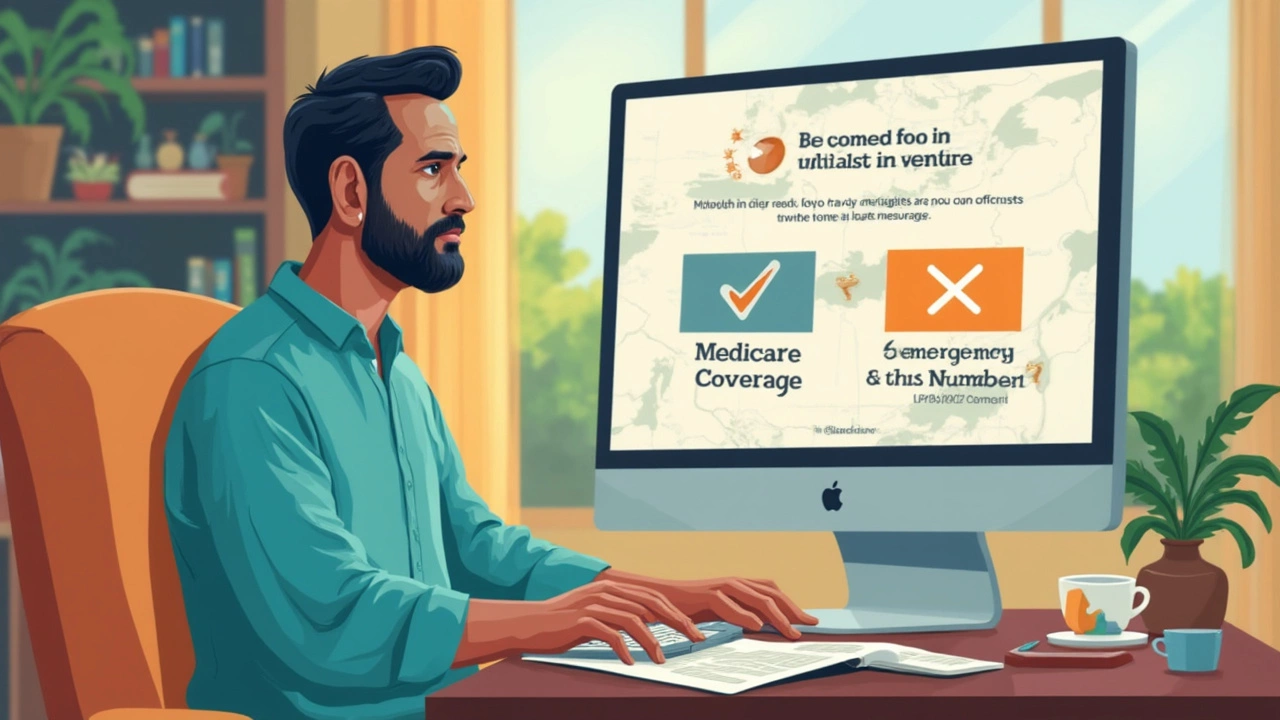Imagine this: You're in Spain and suddenly need to see a doctor. You whip out your red-white-and-blue Medicare card, feeling ready for anything—until you hear, 'Sorry, not accepted.' That’s a surprise nobody wants in a foreign country.
Most people don’t realize Medicare pretty much stops at the U.S. border. Standard Medicare (Parts A and B) won't cover your bills if you're outside the country, with only a few rare exceptions. If you get sick or injured while abroad, you’re usually on your own. That can mean shelling out big bucks for something as simple as a doctor’s visit or a quick hospital stay.
If you love to travel, or you’re planning a big trip, knowing what your health insurance really covers isn’t just smart—it’s necessary. You can’t afford to guess when it comes to your health, especially in a foreign country. Let’s get into the real facts and the best ways to protect yourself if something goes wrong overseas. Because when it comes to medical coverage, what you don’t know can hit hard—and cost even more.
- The harsh truth: Medicare’s limits overseas
- Narrow exceptions: When Medicare might pay abroad
- Gaps that can ruin your trip—and how to handle them
- How Medigap and Medicare Advantage fit in
- Smart moves: Travel insurance and backup plans
- Real-world tips for staying safe and covered abroad
The harsh truth: Medicare’s limits overseas
Here’s something a lot of folks find out the hard way: Medicare doesn’t go with you once you leave the U.S. It sounds blunt, but that’s the reality. Plain and simple, if you rely on original Medicare—that’s Part A (hospital insurance) and Part B (medical insurance)—you’re mostly out of luck if you need care in another country.
The only countries where Medicare will even partly work are the 50 states, District of Columbia, Puerto Rico, U.S. Virgin Islands, Guam, American Samoa, and the Northern Mariana Islands. So if you’re hanging out in Paris, Tokyo, or Sydney, don’t expect your Medicare card to be your safety net.
Here’s a quick look at where Medicare actually covers you:
| Location | Covered by Original Medicare? |
|---|---|
| United States (all 50 states + D.C.) | Yes |
| U.S. territories (such as Puerto Rico, Guam) | Yes |
| Any other country (like Canada, France, Australia) | No |
Surprised? Most people are. The U.S. government just doesn’t pay for care in foreign hospitals or clinics. Even if you find an English-speaking doctor who takes your case, you’ll be paying out of pocket—or wrestling with paperwork to try to get any money back, which hardly ever works.
It gets even trickier if you’re on a cruise. Medicare throws a curveball here: coverage only applies if the ship is within six hours of a U.S. port. Once you’re floating farther out, your coverage floats away too.
So if your only health plan is original Medicare, you’re on your own once you use your passport. That’s the no-nonsense truth. If you’re thinking, “I’ll just deal with it if something happens,” know that hospital stays or even doctor visits abroad can cost way more than most people expect. One night in an overseas hospital can run you hundreds or even thousands of dollars—and yes, you’ll probably have to pay it upfront before you even leave.
Narrow exceptions: When Medicare might pay abroad
Here’s the blunt truth: Original Medicare almost never pays for care overseas. But yes, there are a few tiny loopholes—emphasis on tiny. Knowing these can save you from expensive surprises. Let’s break them down clearly so you don’t get caught out.
- If you’re traveling between Alaska and another U.S. state and you have a medical emergency that requires you to go through Canada, Medicare might pay for care at a Canadian hospital if it’s closer than a U.S. one.
- If you live in the U.S. and there’s a foreign hospital closer to you than the nearest U.S. option (think small border towns near Canada or Mexico), Medicare may cover emergency or urgent care there.
- If you’re on a cruise ship but still within 6 hours of a U.S. port, and you need medically necessary care, Medicare might step in—but only if the doctor is U.S.-licensed.
That’s about it for official exceptions. None of these let you plan a medical procedure overseas and get Medicare to foot the bill. We’re talking only emergencies and only in these rare cross-border situations.
Here’s what most folks really want to know: Routine doctor visits, check-ups, or any non-emergency care can’t be slipped through these loopholes. Don’t count on Medicare for meds, x-rays, or hospital stays abroad, unless you hit one of these narrow cases. Even then, you’ll need documentation and you’ll probably pay the bill upfront, then file for reimbursement.
| Situation | Is Medicare Likely To Pay? |
|---|---|
| Emergency care crossing from Alaska through Canada | Yes, if Canadian hospital is closer |
| Living near the U.S. border with a closer foreign hospital | Yes, for emergencies or urgent needs |
| Cruise ship within 6 hours of U.S. port | Yes, with U.S.-licensed doctor aboard |
| Planned surgery in Europe or Asia | No |
| Prescription refills abroad | No |
Bottom line: If your travel plans involve those edge cases near borders or cruises close to the States, know these very limited exceptions. For everybody else, don’t bank on your Medicare—it’s basically out of the picture once you leave the U.S.
Gaps that can ruin your trip—and how to handle them
Here’s the deal: there are some serious holes in your Medicare coverage when you go overseas. If you need medical care in most countries, you’ll have to pay the full cost out of pocket. Emergency room visits, overnight hospital stays, ambulance rides—none of that is usually covered by Original Medicare. Even a simple broken ankle or a quick x-ray abroad could set you back thousands.
You might think, “What are the chances I’ll actually need care?” Fair question, but mishaps happen fast when you’re somewhere new. The U.S. State Department warns that many foreign hospitals require cash up front—sometimes before they’ll even look at you. That’s a massive risk if you don’t have a plan. Most foreign hospitals won’t do direct billing to American insurance of any kind, including Medicare.
Here’s what’s not covered:
- Routine doctor visits and checkups while abroad
- Medications picked up overseas (even if you have a U.S. prescription)
- Non-emergency treatments
- Medical evacuations (flying home for further treatment)
- Intensive surgeries or long hospital stays
Certain areas add even more confusion. For example, a cruise ship is sort of a gray zone. If you’re more than six hours away from a U.S. port, Medicare says “nope”—coverage usually doesn’t apply. Same if you’re living abroad, not just vacationing. And don’t count on U.S. embassies to pay your bills; that’s a myth.
So, what can you actually do? Here’s how to cover the gaps:
- Buy travel medical insurance. This is the easiest and most reliable way to protect your wallet. A good travel policy can cover emergencies, hospital stays, and even evacuations.
- Get proof of coverage. Most hospitals in countries like France, Australia, or Thailand will want to see your travel insurance card before they treat you.
- Ask your current provider. Some Medicare Advantage plans or Medigap policies may help, but never assume—always double-check the fine print.
- Keep receipts for everything. You’ll typically need to pay up front and then get reimbursed, so detailed paperwork is your friend.
- Make a medical plan before you go. Know where the nearest hospital or English-speaking doctor is located at your destination. A quick Google search for ex-pat clinics can save you a lot of trouble.
Here’s how fast it can add up if you don’t have protection:
| Type of Service | Average Cost (USD) |
|---|---|
| Emergency Room Visit in Europe | $300–$800 |
| Overnight Hospital Stay in Asia | $1,000+ |
| Medical Evacuation to the U.S. | $25,000+ |
Missing this step can wipe out your vacation budget fast. If you’re serious about traveling, make “check my Medicare coverage overseas” the first thing you do, right after booking your flights. Don’t let a gap in coverage ruin your adventure.

How Medigap and Medicare Advantage fit in
If you’re relying on basic Medicare, your coverage outside the U.S. is super limited. But there are two key add-ons people talk about: Medigap and Medicare Advantage. Each handles overseas travel very differently, so let’s break it down in real terms.
Medigap (that’s “Medicare Supplement Insurance”) can help you with emergency care while traveling outside the U.S.—but only certain Medigap plans, and only for specific situations. Plans C, D, F, G, M, and N will pay for emergency care during the first 60 days of your trip. They’ll cover 80% of approved costs after you pay a $250 yearly deductible, up to a $50,000 lifetime limit. But it’s only emergencies. Routine stuff, nope. You pay the other 20%—and if the bill is sky-high, that adds up fast.
- Medigap overseas coverage is for emergencies only.
- Coverage is limited to the first 60 days of each trip.
- You pay a $250 annual deductible and 20% coinsurance.
- Total coverage stops at $50,000 for your lifetime.
Here’s a quick example of what you might expect from Medigap:
| Medigap Rule | How it Works |
|---|---|
| First 60 days only | Yes (per trip, not annual) |
| Deductible | $250/year |
| Coinsurance | 20% (you pay this) |
| Lifetime maximum | $50,000 |
Now, Medicare Advantage (also called Part C) is trickier. These plans are set up by private companies, and some offer emergency coverage for foreign travel—but there’s no guarantee. Think of it as "maybe yes, maybe no." Some plans give you basic emergency protection, but you need to check the plan details before you count on it. Some only help in certain countries, some have strict limits, and some don’t offer international coverage whatsoever.
- Not all Medicare Advantage plans cover emergencies overseas.
- Plan rules, copays, and limits vary widely.
- Always read the fine print before you buy or travel.
If you’ve got one of these plans, call your insurer and ask for details before you book your flights. Don’t rely on assumptions—it’s way too important. Remember, neither Medigap nor Medicare Advantage covers trip cancellation, medical evacuation, or repatriation. You might need a separate travel insurance plan for that.
Smart moves: Travel insurance and backup plans
Once you realize your Medicare card is pretty much useless outside the U.S., the next question is: how do you cover yourself? That's where travel insurance comes in. This isn’t just some upsell at the end of your flight booking—real travel plans can protect you from huge bills if you get injured or sick overseas.
Let’s break down what to look for. First, read the fine print. Not every travel insurance plan gives you real medical coverage. Some are great for lost luggage, but super stingy when it comes to hospital bills. You want a plan that offers at least $50,000 in emergency medical benefits, and higher is even better. Most decent plans also toss in emergency evacuation—think medical jet, not just an Uber to the ER. Evacuation coverage can easily run up to $100,000 or more, which sounds wild, but it’s real. For serious stuff, you don’t want to be paying that out of pocket.
Here’s what to check before you buy:
- Coverage for pre-existing conditions (lots of plans exclude these unless you buy insurance right after booking your trip)
- Total dollar limits for emergency care—it should be crystal clear
- How claims are handled and timelines for reimbursement
- 24/7 customer support in English (sounds basic, but you’ll thank yourself if you need it)
About a third of U.S. travelers pick some sort of travel insurance now. If you’re older, it’s even smarter—medical emergencies get expensive fast. In 2023, average overseas hospital bills for Americans topped $2,600 per day for serious care. Here’s a quick comparison of common plan features for medical emergencies:
| Coverage | Average Limit | Comments |
|---|---|---|
| Emergency Medical | $50,000 - $500,000 | Choose higher if traveling outside developed countries |
| Medical Evacuation | $100,000 - $1,000,000 | Essential if remote/unstable areas on your route |
| Pre-existing Condition Coverage | Varies | Check waiting periods, some plans offer waivers |
And don’t forget: Some Medicare Advantage plans may offer built-in emergency coverage overseas, but they’re all different. Always call your provider before you fly. For most folks, a reliable travel insurance policy is the safest bet. You’ll have someone to call, financial backup, and way less stress if the worst happens far from home.
Bonus tip: Keep a digital copy of your travel insurance card, emergency contacts, and receipts—insurance companies love their paperwork, and a photo on your phone can make things faster and smoother if you need to file a claim.
Real-world tips for staying safe and covered abroad
Traveling overseas with just your Medicare card is a risky move. There’s a reason many savvy travelers make a checklist before they even hit the airport. If you want to avoid nasty surprises, here's what actually works in the real world.
- Don’t assume anything about coverage. Your standard Medicare is almost never enough outside the U.S. If you’re a stickler for details, check your plan’s official summary or call Medicare before your trip.
- Get travel health insurance. Even if you’re healthy, sudden illness or accidents can blindside you. A short-term policy that covers emergency care, ambulance rides, or even medical evacuation can save you from huge bills. Look for a plan with direct billing to hospitals—otherwise you may have to pay up front and claim later.
- Ask about pre-existing condition coverage. Some travel insurances exclude pre-existing problems unless you buy coverage quickly after your first booking. Don’t leave it until the last minute—you could miss your window to get covered.
- Carry your info. Have your policy details and your emergency contact numbers with you. Either print it out or just keep a digital copy handy on your phone. Some travelers even use wristbands or medical ID cards for extra safety.
- Research hospitals before you go. Know the names and addresses of reputable clinics or hospitals at your destination. In an emergency, minutes matter—you don’t want to be googling when things get urgent.
- Medigap and Advantage plans aren’t all equal. Even if you have a Medigap or Medicare Advantage plan that offers overseas emergency coverage, read the fine print. How much will they pay? What’s your share? Some plans have lifetime caps, and most make you pay out of pocket first, then submit receipts for reimbursement.
Here’s a quick number to put things in perspective: according to the US State Department, a medical evacuation from Europe back to the U.S. can cost from $50,000 to $100,000. Regular travel health insurance usually covers much of that.
| Travel Necessity | Why It Matters |
|---|---|
| Travel Health Insurance | Covers emergencies that Medicare won’t touch |
| ID & Insurance Info | Quick access for foreign doctors and hospitals |
| List of Local Hospitals | Saves precious time if something goes wrong |
Another pro move: sign up for the U.S. State Department’s STEP program to make it easier for embassies to help in emergencies. And don’t blow off that weird travel health advice about vaccines or local food risks—it’s not just for backpackers.
The bottom line? If you want to explore the world with confidence, your best bet is to plan ahead. You don’t want to learn the hard—and expensive—way that Medicare overseas coverage just isn’t enough.

 Top US States for Premier Hospital Care and Medical Tourism
Top US States for Premier Hospital Care and Medical Tourism
 How Long Is the Average Stay in Rehab After Knee Replacement?
How Long Is the Average Stay in Rehab After Knee Replacement?
 Can You Really Get Wegovy for $25?
Can You Really Get Wegovy for $25?
 Open Heart Surgery Recovery: What You’ll Need at Home
Open Heart Surgery Recovery: What You’ll Need at Home
 Can You Avoid Knee Replacement if You Are Bone-on-Bone?
Can You Avoid Knee Replacement if You Are Bone-on-Bone?